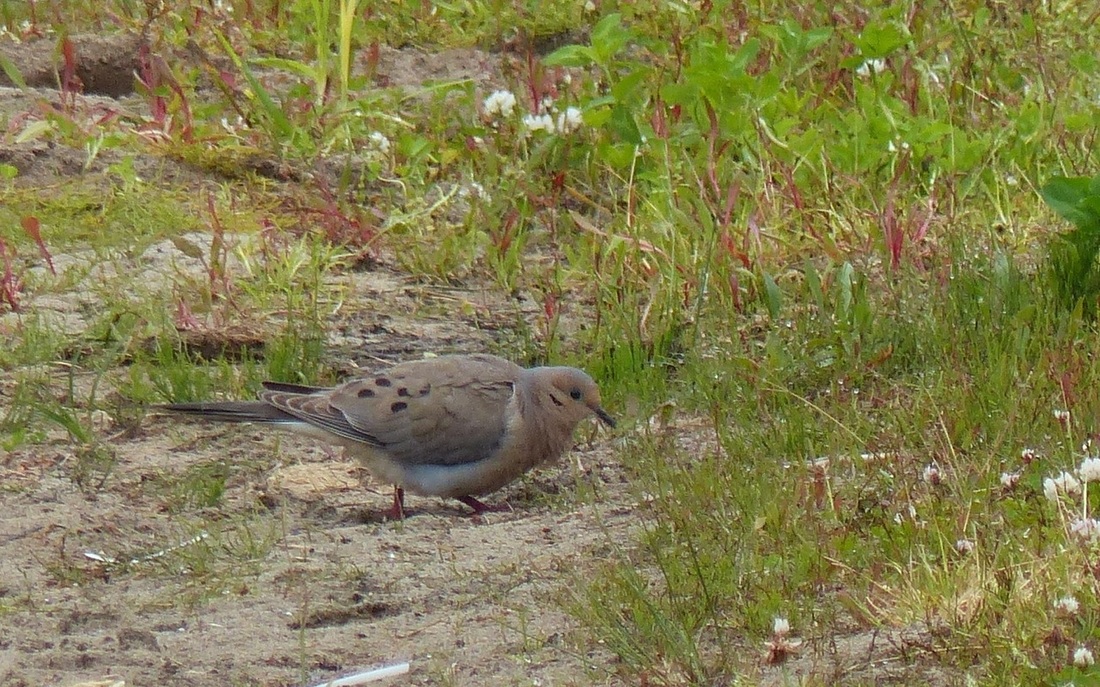Mourning dove • Zenaida macroura
{macroura = long-tailed}
Identification
The mourning dove has black teardrop-shaped spots on its wings and a dark spot on its cheek. It is a light brownish to buff colour overall, with a pinkish wash on its underside. It is slender, with a long tapered tail and a small head. The mourning dove's song is a soft and mournful coo
Habitat & Range
While this species is commonly inhabits open areas with many nearby trees and shrubs, such as lawns, fields, and park, it can be found in a wide variety of habitats. Normally an uncommon visitor to these northwestern latitudes, the mourning dove is a year-round resident as far north as Port Alberni on Vancouver Island. It breeds in interior areas of southern Canada and northern United States. It is a common and abundant bird within its range.
Find more information at the British Columbia Breeding Bird Atlas here.
Similar Species
The Eurasian collared-dove (Streptopila decaocto), also an uncommon visitor, has a black collar mark on the back of its neck and lacks the mourning dove's black wing spots. The rock pigeon (Columba livia) and the band-tailed pigeon (Patagioenas fasciata) are more commonly found on the Central Coast: they are larger and darker in colour.
Intriguing Info
The mourning dove is the most commonly hunted species in North America. It is a fast flier.
The mourning dove has black teardrop-shaped spots on its wings and a dark spot on its cheek. It is a light brownish to buff colour overall, with a pinkish wash on its underside. It is slender, with a long tapered tail and a small head. The mourning dove's song is a soft and mournful coo
Habitat & Range
While this species is commonly inhabits open areas with many nearby trees and shrubs, such as lawns, fields, and park, it can be found in a wide variety of habitats. Normally an uncommon visitor to these northwestern latitudes, the mourning dove is a year-round resident as far north as Port Alberni on Vancouver Island. It breeds in interior areas of southern Canada and northern United States. It is a common and abundant bird within its range.
Find more information at the British Columbia Breeding Bird Atlas here.
Similar Species
The Eurasian collared-dove (Streptopila decaocto), also an uncommon visitor, has a black collar mark on the back of its neck and lacks the mourning dove's black wing spots. The rock pigeon (Columba livia) and the band-tailed pigeon (Patagioenas fasciata) are more commonly found on the Central Coast: they are larger and darker in colour.
Intriguing Info
The mourning dove is the most commonly hunted species in North America. It is a fast flier.
References
Dunn, J. L. and Alderfer, J. (Eds.). (2011). National Geographic Field Guide to the Birds of North America. (6th Ed.). Washington, D.C.: National Geographic Society. Pp. 266-267.
Mourning Dove. The Birds of North America Online (A. Poole, Ed.). Ithaca: Cornell Lab of Ornithology. Retrieved from the Birds of North America Online. Accessed 15/10/2014.
Mourning Dove Zenaida macroura. Audubon Birds. National Audubon Society. Accessed 15/10/2014.
Authors and editors of page
Kelly Fretwell, Misha Warbanski, and Brian Starzomski (2014).
Dunn, J. L. and Alderfer, J. (Eds.). (2011). National Geographic Field Guide to the Birds of North America. (6th Ed.). Washington, D.C.: National Geographic Society. Pp. 266-267.
Mourning Dove. The Birds of North America Online (A. Poole, Ed.). Ithaca: Cornell Lab of Ornithology. Retrieved from the Birds of North America Online. Accessed 15/10/2014.
Mourning Dove Zenaida macroura. Audubon Birds. National Audubon Society. Accessed 15/10/2014.
Authors and editors of page
Kelly Fretwell, Misha Warbanski, and Brian Starzomski (2014).




